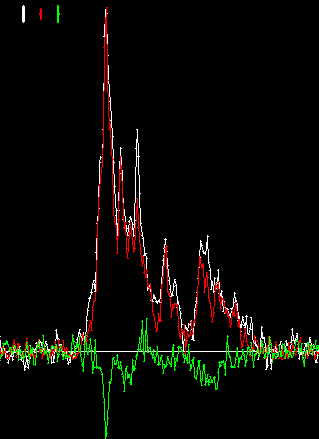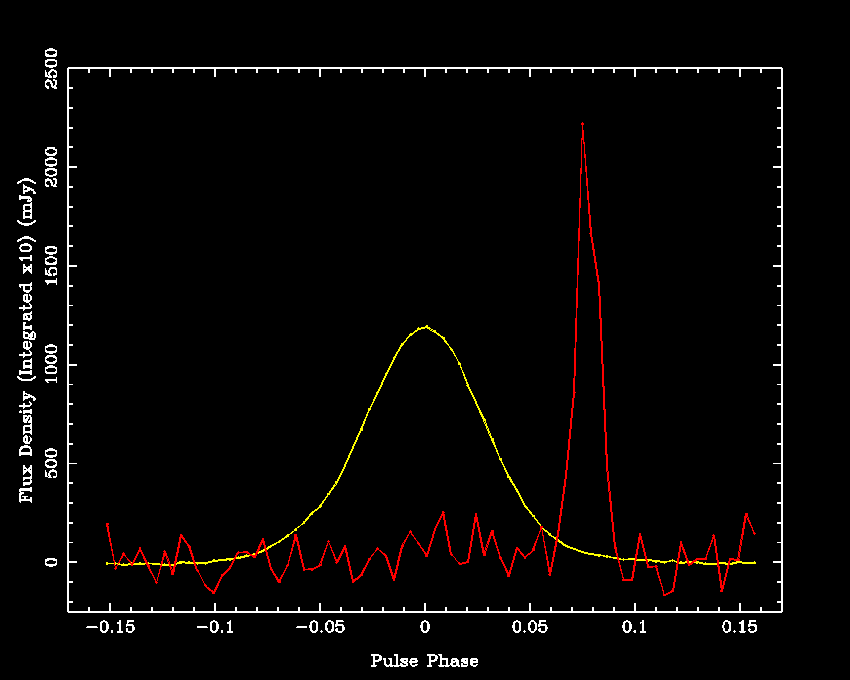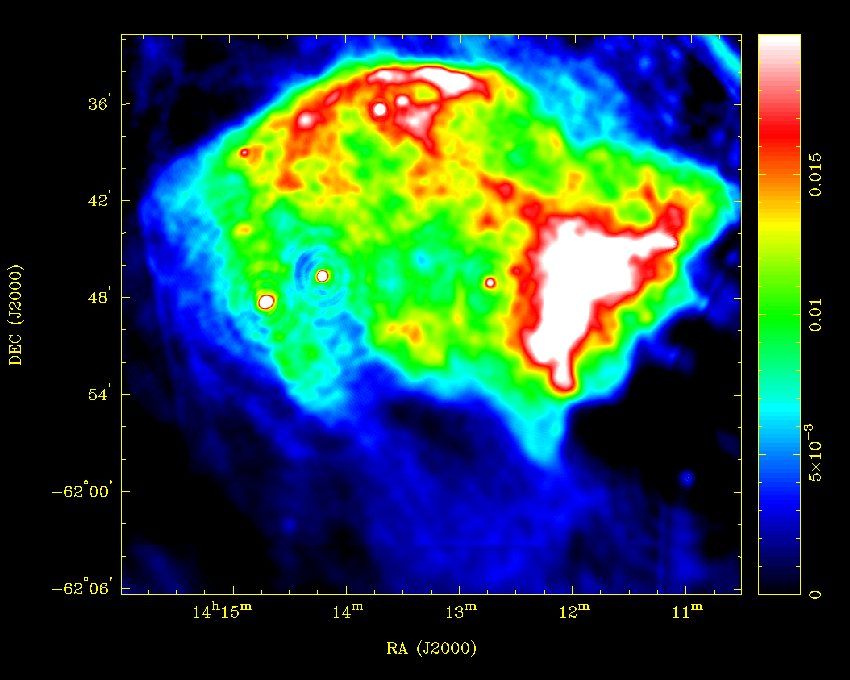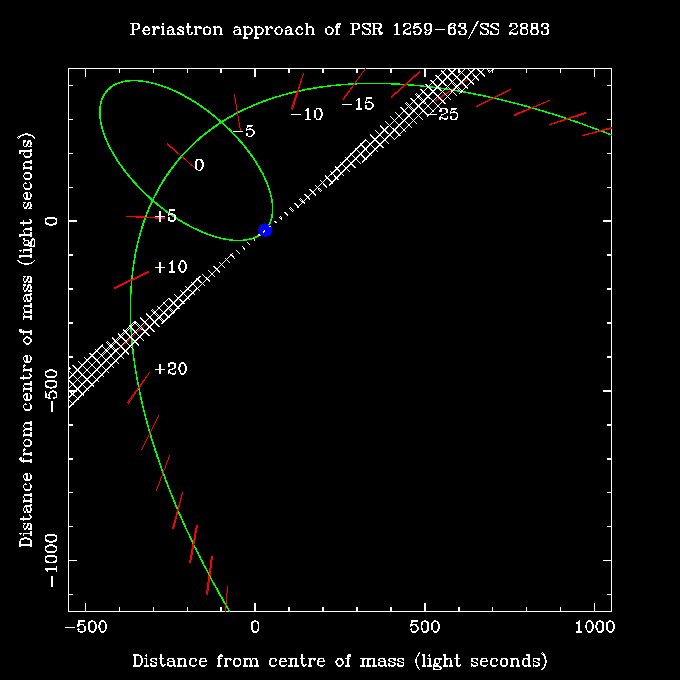My Research Interests
Polarization and integrated profiles
The polarization of integrated pulsar profiles offer an insight into the emission processes going on in the magnetosphere and give a handle on the pulsar geometry. Phase analysis of the profile gives you the longitudonal structure in the beam and multi-frequency analysis can give the vertical structure of the magnetosphere. All this sounds great but in practice this mapping is difficult to achieve for a variety of reasons.Projects I have been doing include high frequency observations of southern pulsars (at 3.1 GHz; Karastergiou, Johnston and Manchester 2005, and at 8.4 GHz; Johnston, Karastergiou and Willett 2006) and some neat observations of young pulsars (Johnston and Weisberg 2006) where we came to some bold conclusions about their profiles. Finally, we have shown that the rotation axis and the velocity vectors of pulsars are aligned (Johnston et al. 2005) with the implications that has for their birth processes.
In 2006, I embarked on a mega-campaign to observe more than 200 pulsars at at least 3 different frequencies. The high time resolution and absolute polarization position angles will make this a fascinating data set to mine. Watch this space. 
Single Pulses
Not only do I like polarization from integrated profiles but the polarization from single pulses is equally if not more fascinating. This was the topic of my QEII Fellowship which ran from 1999-2004.Starting on Vela, the strongest pulsar in the sky seemed like a good idea. Surprisingly, we found two features not detected before. These are giant micro-pulses and the `bump' component. Giant micro-pulses are very large amplitude pulses which occur (at least in Vela) before the main pulse. They are rather rare and contribute little to the overall flux from the pulsar. The `bump' component is a new component which occurs towards the tail of the main profile. This serves to broaden the profile which has implications for the viewing angle of the pulsar (Johnston et al. 2001).
We also detected micro-structure in the Vela pulsar with a width of only about 40 microseconds and looked at the distribution of circular polarization in the single pulses. A comprehensive write-up is in Kramer et al. (2002). The figure on the right shows a single pulse from Vela. The micro-structure is clearly present. The flip of the sign of circular under some micro-structure features can also be seen.
We also looked at the intensity distribution of the single pulses in Vela as a function of pulse phase. We find that the distribution is log-normal. The implications of this for the emission physics is discussed in Cairns et al. (2001).
I'm also involved with observations made with the European Pulsar Network. They use multiple telescopes to observe the same pulsar at different frequencies. The data quality is superb, what it all means is something else again. We've published a significant amount of these data, with the lead taken by my ex-student and now ex-postdoc Aris Karastergiou. 
Giant Pulses
Roger Romani and I carried out observations at Parkes during 2001 with the aim of detecting giant pulses from a variety of pulsars. Prior to these observations only the Crab and the millisecond pulsar PSR B1937+21 were known to have giants. We were therefore happy to discover evidence for giant pulses in the millisecond pulsar PSR B1821-24 (Romani & Johnston 2001).We also found an example of giant pulses in the Vela-like pulsar PSR B1706-44. In the figure, the red profile is the giant pulse, the yellow profile is the integrated profile multiplied by a factor of 10. These may be similar to the micro-pulses in Vela. It's not clear where the giant pulses originate - are they a polar cap phenomena like the bulk of the radio emission or are they related to the high energy emission from the outer gap. Check out the discussion in Johnston & Romani 2002.
We then discovered the first example of extra-galactic giant pulses in the LMC pulsar 0540-69 (Johnston & Romani 2003). We only see one giant pulse every 30 minutes or so. We tried simultaneous observations with the RXTE satellite but failed to see any correlation between the X-ray fluxes and the radio giants.
HI Absorption Towards Pulsars
The Frail & Weisberg (1990) review of pulsar distances listed 50 pulsars with HI measurements. Most of these were northern hemisphere objects. A group of us therefore embarked on a campaign to HI towards a large sample of southern pulsars, especially those along the tangents to the two main spiral arms in the galactic plane. To date, we've done more than 23 pulsars (see Koribalski et al. 1995, Weisberg et al. 1995, Johnston et al. 1996 and Johnston et al. 2001). Our basic conclusions were that the Taylor & Cordes (1993) distance model does a reasonable job in the galactic centre but is less good through the spiral arms. These data were then used in the modified model of Cordes & Lazio.I've also tried to measure differences between HI absorption profiles at various epochs using the Parkes telescope and a velocity resolution of 0.1 km/s. This has had mixed success thanks to a correlator problem during the second epoch of observations.

EGRET Sources
Mallory Roberts and Roger Romani got me involved in looking for radio counterparts for southern EGRET sources. We've had pretty good success with the so-called Kookaburra object in the radio. It contains all sorts of goodies including a `Rabbit' which is likely to be a Pulsar Wind Nebula (PWN). Within the Rabbit is a hard X-ray source but no pulsations have been found at either X-ray or radio wavelengths. This could be the companion to 2EGS J1418-6049. On the other hand, in the northern wing of the Kookaburra lives a young radio pulsar which has since been detected pulsating in X-rays also. Perhaps it is more likely to be the gamma-ray source. Have a look at Roberts et al. (1999) and Roberts et al. (2001) for more details.
My Honours student in 2001, Michelle Doherty, looked at the EGRET source 3EG J1410-6147. It appears to be associated with the radio supernova remnant G312.4-0.4. Contained within the SNR are two young pulsars, one 13 kyr old and the other 50 kyr. Either of these could be associated with the SNR and/or the gamma-ray source. We carried out HI measurement on the SNR to try and determine its distance. This nice image on the right shows the SNR as observed with the ATCA in the 20cm band.

PSR B1259-63
What would life be without my favourite pulsar, PSR B1259-63? It's still the only radio pulsar with a Be star companion (Johnston et al. 1992, 1994), although there are 2 other pulsars with high-mass companions these days. It's in a 3.4 yr orbit with high eccentricity. The timing of the pulsar is described in gory detail in Wex et al. (1998).All sorts of goodies happen at the point of closest approach of the two stars - periastron. The figure on the right shows a blow-up of the orbit around the time of the periastron. The white hatchings are the approx size of the disk around the Be star. It's clear that the pulsar passes through the disk about 15 days before periastron and about 20 days after. Around 17 days prior to periastron a radio transient appears. It peaks at about 60 mJy 10 days or so before periastron then decays until about 18 days after periastron when it peaks again. This light curve is obviously related to the disk crossings. Check out Johnston et al. (1999) for observational details and Ball et al. (1999) for the model of the system. My 2001 Honours student, Tim Conners was working on the data from the 2000 periastron passage.
The pulses do strange things close to periastron too. They become depolarized and also change linear polarization into circular polarization at specfic places in the orbit. Closer to periastron the dispersion measure starts to rise, the flux density of the pulsar goes down and the pulses scatter broaden. Eventually the pulses become eclipsed thanks to a combination of optical depth and scattering. The eclipse lasts more than 30 days, or about half the orbital angle. Johnston et al. (2001) has the details.
There is currently a proposal to do VLBI on PSR B1259-63 in order to measure its proper motion and parallax. This should yield an accurate distance to the system and may allow us to determine the masses of the two stars. The proper motion is expected to be around 25 km/s and this value plus the vector should throw some light on the evolution of this system and the question of natal kicks.
Pulsar Scintillation
Last modified: Aug 2006
